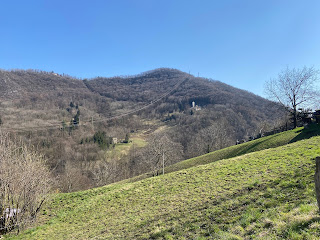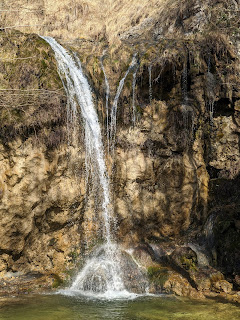Overview | Notes | Flora, Fauna, Fungi | Macro Photos | Trail Photos


Upper left: Hiking tracks from Bergamo to Buche di Nese.
Upper right: Olera, a small village north of Bergamo.
Lower left: A waterfall and pool on the Nesa River, one of the "Buche di Nese".
Lower right: A view from Burro (a small hamlet south of Monte Nese) looking east toward Brumano.
Overview
Length: ~ 26 km (16 miles)
Duration: 7 hours (includes ½ hour lunch)
Elevation: gain
1,533 m (5,030 ft), max 898 m (2,946 ft) near Canto Basso, min 262 m (860 ft) –
Bergamo.
Location: Italy, Lombardia, Bergamo, Colli di Bergamo, Monte
Nese
Notes
Today's hike was about exploring what are called Le Buche di Nese, "the holes of Nese" located on the Torrente Nesa, a fascinating and magical environment not far outside of Bergamo. You can get there by car or bus (26) or walking from Bergamo, which is what we describe here. It's a long walk that takes in some popular trails in the hills north of Bergamo.
The holes of the Nesa River are small pools along with waterfalls created as the stream makes a short 7 km run from its source, Monte Corna Bianca, to empty into the Serio river. The Nesa river is a spot for canyoning.
The waterfall that is the easiest to reach without much effort is what we'll call the lower one (here). From that point, we only explored upstream. To go upstream after this first waterfall, you need to work to see more. To the left of the lower waterfall is a tricky steep path to another set of pools. We arrived there and had a quick snack. From there, we tried pushing upstream some more but realized it was too dangerous. We were not outfitted for canyoning and the sides of the stream were too steep to navigate. At that point, we tried to climb out on a barely visible trail grasping on clumps of grass, but it turned out to be too steep and we weren't sure where it would lead to. So, slightly defeated we backtracked to the first waterfall and started our journey back to Bergamo.




Views of the Nesa River, waterfalls and pools, known as "le buche di Nese".
To arrive at the lower waterfall from Bergamo, follow trail 533 (from
Monterosso) and switch to trail 532. You are
going from Bergamo to Burro, the small hamlet just above the waterfalls. There
are a number of variations to this hike such as dropping down into the charming
town of Olera, or how you
circumnavigate Monte Colletto. Going we dropped into Olera and went along the south
side of Monte Colletto. Returning, we passed through the town of Monte di Nese (north of
Monte Colletto) and avoided dropping down to Olera. Given the length of the
walk, it would be wise to have one or more stopping points in Olera, Monte di
Nese or Burro. Eat lunch or at least grab a coffee at a local bar or restaurant.
(Unfortunately, all this was off limits to us today as we are in
"orange" alert for coronavirus, which means no service except
take-away and given that restriction, most places just close.)
Flora, Fauna, Fungi
First let's talk about fauna and fungi, not our strong suit. The following were spotted and photographed (see Macro section):
- [Lacertidae] Lacerta bilineata – Western Green Lizard {called ramarro occidentale in Italian}
- [Polyporaceae] Trametes versicolor – Polypore Mushroom (a shelf mushroom)
The lizard was quite a surprise. We are used to seeing
small little lizards all the time, like Podarcis muralis (common wall
lizard in the same family) especially in the city. During our walk today we'd
hear leaves rustling on the sides of the trail as little lizards scurried away.
So this Western Green Lizard was a surprise for its size and the fact
that it didn't move at all. We stopped (near Canto Basso) to look at a beetle
on the ground – that's what we do – and while fiddling with our cameras saw
this lizard staring at us. It didn't move a muscle. It just sat there soaking
up the last of the afternoon sun or waiting for his photo to be taken.
All of our flora finds on this hike are typical of this time of year, late winter not quite spring. Typical, but pleasant and particularly cheerful on this sunny Sunday of the never ending pandemic lockdown.
A standout as usual is the Dogtooth Violet, which has a surprising number of culinary uses – none that we've tried or even seen featured. From Wikipedia: "Its leaves may be consumed raw in salad, or boiled as a leaf vegetable. The bulb is also the source of a starch used in making [a type of ] vermicelli." It's called dogtooth (dens-canis) because the bulb resembles a dog tooth.
The "far-away" photos of flowers were taken with standard issue cellphones. The better quality, close-up photos were taken with a Canon EOS M6 with 100 mm macro F1.2 lens.
The "brown" looking hills in some photos are deciduous stands of Carpino betulus (hornbeam or carpino) and Quercus robur (oak or roverella, farnia, quercia). Mixed in may be other trees like Corylus avellana (hazel or nocciolo), Alnus glutinosa (alder or ontano) and others trees like Cornus mas (Conelian cherry or corniolo). There is a term, querco carpineto, that refers to stands of forests that are primarily hornbeam and oak, such as is Monte Colletto above Olera. Many of the plants we photographed today are typical of querco carpineto. Querco carpineto are managed forests in that they are periodically cut.
Finally, a curiosity: three of the species spotted today have wort in their common name, including Lungwort, Liverwort, and Milkwort.
[Family] Genus species – Common name in English {Common name in Italian}
[Asteraceae] Tussilago farfara – Coltsfoot {Tossilaggine
comune}
[Boraginaceae] Pulmonaria sp. prob P. officinalis – Lungwort {Polmonaria}
[Cornaceae] Cornus mas – Cornelian Cherry {Corniolo}
[Ericaceae] Erica carnea – Winter Heath {Erica
carnicina}
[Lamiaceae] Adjuga reptans – Bugle {Bugola}
[Liliaceae] Erythroninum dens-canis – Dog's-tooth-violet
or Dogtooth violet {Dente di cane}
[Polygalaceae] Polygala chamaebuxus – Shrubby
Milkwort {Poligala falso bosso}
[Primulaceae] Primula vulgaris – Primrose {Primula
comune}
[Ranunculaceae] Anemone nemorosa – Wood anemone {Anenome
bianca}
[Ranunculaceae] Helleborus niger – Christmas rose {Elleboro
nero}
[Ranunculaceae] Hepatica nobilis – Liverwort {Erba
trinità}
[Violaceae] Viola odoratum – Sweet violet {Viola
mammola}
[Violaceae] Viola alba – White violet {Viola
bianca}
N.B. What are identified as V. odoratum are in retrospect probably just a variation of V. alba.![[Asteraceae] Tussilago farfara [Asteraceae] Tussilago farfara](https://blogger.googleusercontent.com/img/b/R29vZ2xl/AVvXsEgXHXnMkaT34QO69o5NZ0mtiggNDuicLn3sJiibnJ7UTZ4RkgyH7BI7lo8ffGcUZbSEglAmuHl-mwS3awZsWSnigOwR0M-GOSs0lEfCFED6nHWl4GuZfKeAXQANA3DsbAPTySKy0YzKZFY/s320/%255BAsteraceae%255D+Tussilago+farfara.jpg)
![[Boraginaceae] Pulmonaria [Boraginaceae] Pulmonaria](https://blogger.googleusercontent.com/img/b/R29vZ2xl/AVvXsEhGTuQoZG1nlVp-pJYPP_JLDD35SeDaa_YJxqaJtF7ZyYWSrj8wo8mQoFvdMhTQPAQzoaKTON6SjRInc8rwomRsDmB-7mYbX95eRWLsJg6knVIVgWrU18JBja-v5vLnQfoPgz6mBF-juyQ/s320/%255BBoraginaceae%255D+Pulmonaria+1.jpg)
![[Boraginaceae] Pulmonaria [Boraginaceae] Pulmonaria](https://blogger.googleusercontent.com/img/b/R29vZ2xl/AVvXsEioV9djNjp_OA5nzk4VuRoIKvmJ9yK2xkcaiH_vV5W6FruPAxbBBC4O0m4vKWPgwHJ2eKM-ahTNvQGqiM5jHVtRX8pU7P_N4x4wtZMcZo162PmIf2ugtxEGICy2QNVMvfpoL0SAo28H444/s320/%255BBoraginaceae%255D+Pulmonaria+mixed+with+others.jpg)
![[Cornaceae] Cornus mas [Cornaceae] Cornus mas](https://blogger.googleusercontent.com/img/b/R29vZ2xl/AVvXsEgXku_d74baavRFNEh5c3ac2FPge6UvuFLpVKOOVOFaqGPoTcOT1JV11iKrQJJSgsLACUnkdZ0ImxX1YRhMxBdRVlty31BIJn-0AFHL0ZNczozRjQMsqskfg74M-M3AYCZQs9xdyML1EQo/s320/%255BCornaceae%255D+Cornus+mas+2.jpg)
Left: [Asteraceae] Tussilago farfara
Center left and center right: [Boraginaceae] Pulmonaria
Right: [Cornaceae] Cornus mas
![[Lamiaceae] Adjuga reptans [Lamiaceae] Adjuga reptans](https://blogger.googleusercontent.com/img/b/R29vZ2xl/AVvXsEg_JQtO8_O6r3KeEfWPqAaWofuwUHKvgZWCyyqOKmkDGHUyUl_eKQi60lw06_xa6Cy9i83jLnucKjDYe1hT0Qw3kWpc-g_GoQ1D_LvjI16UXdKWPLnSKerfCKQNIIsQmYcRNMatji1Q8bs/s320/%255BLamiaceae%255D+Adjuga+reptans+1.jpg)
![[Lamiaceae] Adjuga reptans [Lamiaceae] Adjuga reptans](https://blogger.googleusercontent.com/img/b/R29vZ2xl/AVvXsEj6JQyYMkrOHn2kBuFb7ttCu_qgrK5K-1hxaJ0_sSPgi7KQBXfb7DQSXfE8bGkW-JMac8klhvAb_AHZ2LCqPtWW5vyxqbu378V-mb7htedpPFYyLSDADBqzBp8y-I80SWImFCWqyd31YBM/s320/%255BLamiaceae%255D+Adjuga+reptans+2.jpg)
![[Polygalaceae] Polygala chamaebuxus [Polygalaceae] Polygala chamaebuxus](https://blogger.googleusercontent.com/img/b/R29vZ2xl/AVvXsEhwKfOKM9GUaAl2DFvJwCQYmjNnWlBl601leXH_GDJobdQaRWqHUUu16L6rEspRFDM8kX7yFy8043xxDIuHenrgZoiIASGzXNMHJa5y-_szdiNCdOUus3wJ5SuMPxlq2dJM2a1oty-X-Ks/s320/%255BPolygalaceae%255D+Polygala+chamaebuxus+-+yellow.jpg)
![[Polygalaceae] Polygala chamaebuxus [Polygalaceae] Polygala chamaebuxus](https://blogger.googleusercontent.com/img/b/R29vZ2xl/AVvXsEi_bNwGNLpaW8m0RYX5ZDljOlUxobv7YFlW2I7UjwdEMWPU3iHQfHZzO3jizwmDBcppNaLLN5fI_MFYXJJQmsrV9sPKh7t18Pw-_MCDREojR5x14QlaTFQIPxA04-YXHtE-JmOC-CzPUps/s320/%255BPolygalaceae%255D+Polygala+chamaebuxus.jpg)
Left and center left: [Lamiaceae] Adjuga reptans
Center right and right: [Polygalaceae] Polygala chamaebuxus
![[Primulaceae] Primula vulgaris [Primulaceae] Primula vulgaris](https://blogger.googleusercontent.com/img/b/R29vZ2xl/AVvXsEjYG_tgPIQPJXl8IHugKpez1DJIy0iiY23OQO4RfRg4sB4HCFi1EcKRFFwDg761H6T_iYiuNYehTczfNJr689UDbpwpsx9aBOA-wL88K71hgPHugKsIbrhcG2IzEDLCo6TqMrK8LxAaxkU/s320/%255BPrimulaceae%255D+Primula+vulgaris+-+bunch.jpg)
![[Ranunculaceae] Anemone nemorosa [Ranunculaceae] Anemone nemorosa](https://blogger.googleusercontent.com/img/b/R29vZ2xl/AVvXsEiO8ZWYZpDAMCmQ-fXwi25WToG9A1FZQ_SWTqCjFvpYdFWJwjM7eb1ODn7u4sK0IKVeYmvGvMCZzWB8TYi7JkH6Ob2KWeZGjT4yVZSJifEqmEbFdHJb6Z9Wr8dnU1gTPXUqrtv8qDtMOX4/s320/%255BRanunculaceae%255D+Anemone+nemorosa+3.jpg)
Left: [Primulaceae] Primula vulgaris
Right: [Ranunculaceae] Anemone nemorosa
![[Violaceae] Viola alba [Violaceae] Viola alba](https://blogger.googleusercontent.com/img/b/R29vZ2xl/AVvXsEi9FcRs26bRsuk2dSYXCnpH_5zzfLrlPtdLiwdpLylB0ZEKyF2x4UTrKASNYk6b3VEhnPYHYN9krLQSCWLnvaeXVxjW2wJ9pVbc7pg2pZ2gbVFCfGVhwgqwJDCztEyacRWHghXUd87kcAQ/s320/%255BViolaceae%255D+Viola+alba+1.jpg)
![[Violaceae] Viola odoratum and Viola alba [Violaceae] Viola odoratum and Viola alba](https://blogger.googleusercontent.com/img/b/R29vZ2xl/AVvXsEgBvxfhE8IcV1eC5SNeOwqbarBa3h6j6rzLKKDRSwbNfpl-iU5HT3k0Qks8gEXgHtZme9SOZiWUbz0QB6DK_q-zY1kjoXDtr-Ex65ANTenj5Ek3L0EGMe6RqutTfYTf604NPFAGQi6B0XU/s320/%255BViolaceae%255D+Viola+sp.jpg)
Left: [Violaceae] Viola alba
Right: [Violaceae] Viola odoratum and Viola alba
Macro Photos
![[Liliaceae] Erythroninum dens-canis – Dog's-tooth-violet or Dogtooth violet [Liliaceae] Erythroninum dens-canis – Dog's-tooth-violet or Dogtooth violet](https://blogger.googleusercontent.com/img/b/R29vZ2xl/AVvXsEjArwkYT4SmQ8POMRxYRzcczIUkR00SeUZ-LnEbMRomlYMyrJO-hF9YGcUPjWt4b8qMkC1qrLJuJXuOXW9V7iXGtQJf9rzdGR-vxI4oU05Q4_Gvlp_QFPTaZ7o2SRm7px45yJNb-yl7KR8/s280/%255BLiliaceae%255D+Erythroninum+dens-canis+1.jpg)
![[Liliaceae] Erythroninum dens-canis – Dog's-tooth-violet or Dogtooth violet [Liliaceae] Erythroninum dens-canis – Dog's-tooth-violet or Dogtooth violet](https://blogger.googleusercontent.com/img/b/R29vZ2xl/AVvXsEifSG7mMNOIWcxn0jFqv5e9f8lGXtmtbeRQ8AV2nDRJdMAgkIh9RG78dy-afFNwoylQui1wqeV-nzEiWgMJ8yvsLlQf3LEKfyAuJ_Fp6l3oQ_Yvwc18Hrlsb1Vrkc-HwB2oY8DKK1GQCow/s280/%255BLiliaceae%255D+Erythroninum+dens-canis+2.jpg)
[Liliaceae] Erythroninum dens-canis – Dog's-tooth-violet or Dogtooth violet
![[Liliaceae] Erythroninum dens-canis – Dog's-tooth-violet or Dogtooth violet [Liliaceae] Erythroninum dens-canis – Dog's-tooth-violet or Dogtooth violet](https://blogger.googleusercontent.com/img/b/R29vZ2xl/AVvXsEiAnad6Szl9u8y9qzfmITiQp5_9RQQA9bxQcXTUjGKz2B8IqyEly5omjNa1Wa5oRbhzMbDPa5dtD-oeoKFb4NvhYO-0zpiTKLGcrM3691A8Vug1Y34j-LcF2nvIWfYbDFicNCvsc_aSiuE/s280/%255BLiliaceae%255D+Erythroninum+dens-canis+3.jpg)
![[Liliaceae] Erythroninum dens-canis – Dog's-tooth-violet or Dogtooth violet [Liliaceae] Erythroninum dens-canis – Dog's-tooth-violet or Dogtooth violet](https://blogger.googleusercontent.com/img/b/R29vZ2xl/AVvXsEirC68amAUZ9ZopD1kQ8NUCRbU-XlrYfMylnVo9Kfu5eJmhOKo-AhKJcqrfn5hAsXUlJw8G47hZ7gFFDD3W1ZO_yUMX9TfekjLdWunylTjnA1imnoGGiVYrYfQk5c-nypsGg8rI-79j8YE/s280/%255BLiliaceae%255D+Erythroninum+dens-canis+4.jpg)
[Liliaceae] Erythroninum dens-canis – Dog's-tooth-violet or Dogtooth violet
![[Polyporaceae] Trametes versicolor – Polypore Mushroom (a shelf mushroom) [Polyporaceae] Trametes versicolor – Polypore Mushroom (a shelf mushroom)](https://blogger.googleusercontent.com/img/b/R29vZ2xl/AVvXsEi1fCnxjBY9WTaWF6V0Ti6GTEWndLTEXOrw3wRpuT6vyyDGTSLAhYf9zH2NPUcoLqByJvohDVGdMB3llkVLcXMZc0Uo-LaP-6ong8CxnWqjC436kl4teSOp-gaxDqr50BbAzWfyd_QKfW0/s280/%255BPolyporaceae%255D+Trametes+versicolor.jpg)
![[Primulaceae] Primula vulgaris – Primrose [Primulaceae] Primula vulgaris – Primrose](https://blogger.googleusercontent.com/img/b/R29vZ2xl/AVvXsEgtkwL2yT71j-dxPwUZfC1SniP7sUiNJZhNv9rzIjzjTcT21ZaP7m9O277NO0SrB024mPSEW9fwdu5wwLlb-BSnloLIZ0EXWF56_iMGyja9PPrz-XmkJ0clLUgBrw4cm7H6xIGaqyfoAno/s280/%255BPrimulaceae%255D+Primula+vulgaris.jpg)
Left: [Polyporaceae] Trametes versicolor – Polypore Mushroom (a shelf mushroom)
![[Ranunculaceae] Anemone nemorosa – Wood anemone [Ranunculaceae] Anemone nemorosa – Wood anemone](https://blogger.googleusercontent.com/img/b/R29vZ2xl/AVvXsEhtBpfYDoOhb4HsSmvSqrpxw9Yjpafwv8l560P8MjjWWbho5Q5_CA7HrKP_yP-S3QnbmiC7vx6m86bPp3eDRf-_RO3xQN7EyW6scCqus-5_0ljeyhBET7yBAThxjt_870QrrinRkvfJK0A/s280/%255BRanunculaceae%255D+Anemone+nemorosa+1.jpg)
![[Ranunculaceae] Anemone nemorosa – Wood anemone [Ranunculaceae] Anemone nemorosa – Wood anemone](https://blogger.googleusercontent.com/img/b/R29vZ2xl/AVvXsEi8ugNb4phc0Cpw6Y_ZyBLsVpf07pPGaemqqM5uOshun2I_EvV6-H9sCx9X0BHWGThJJvdGoKYlZEDPIWUp06mstQ5TGMZrTQrJqKB84Gfn9v6QrNMHCcjcuDL726R9fn-wPfSi4azT6s4/s280/%255BRanunculaceae%255D+Anemone+nemorosa+2.jpg)
[Ranunculaceae] Anemone nemorosa – Wood anemone
![[Ranunculaceae] Helleborus niger – Christmas rose [Ranunculaceae] Helleborus niger – Christmas rose](https://blogger.googleusercontent.com/img/b/R29vZ2xl/AVvXsEgPpmMiIE-6Na2bcFHTOT9xEEXLGJv2lIpBHQmPB4DAwDYy1YNHARzWKfKDw7kvYONXc9S0hp5Vx6Zq1wBch2qV3f9sC2JF1LEpInxsgGJZI1kMC_4m0LZ9xRmYA-1qEE94oXEtne71E2k/s280/%255BRanunculaceae%255D+Helleborus+niger+1.jpg)
![[Ranunculaceae] Helleborus niger – Christmas rose [Ranunculaceae] Helleborus niger – Christmas rose](https://blogger.googleusercontent.com/img/b/R29vZ2xl/AVvXsEhum_ViS9zXSwBPphx9iYM1dj1ntldD0MnIB2y2a5NcRVmKtNph91_OjiFDguAK-HnXfw0dLHoIB-Ux3_fW6Spf6dKvDcNZAr3lpOhvIic4mTiJvEHNxWpQuaff8FfyudLl4_ZBhVcj_kQ/s280/%255BRanunculaceae%255D+Helleborus+niger+2.jpg)
[Ranunculaceae] Helleborus niger – Christmas rose
![[Ranunculaceae] Hepatica nobilis – Liverwort [Ranunculaceae] Hepatica nobilis – Liverwort](https://blogger.googleusercontent.com/img/b/R29vZ2xl/AVvXsEifz1j0V1iX6zdVf6jNM0MGtqFzI0m3_pDtVmgQPV01rM6BpDxzMIfx8k-wxt1srv76peRh6QmRdb-t4iELNahTse2_ZXA3xkBAs0XDaFyxPwhGkvd9EzFjoRHNjz2DVxRlw5bMzifp7ck/s280/%255BRanunculaceae%255D+Hepatica+nobilis+1.jpg)
![[Ranunculaceae] Hepatica nobilis – Liverwort [Ranunculaceae] Hepatica nobilis – Liverwort](https://blogger.googleusercontent.com/img/b/R29vZ2xl/AVvXsEjBQxb5RfTq70mHbZTjfTZpfcwH2mEwQcCjDWbBtN53WgMFgEsW9Qw4jD3DNWFn7InM8Q0SuW3zr3_tJsmD6EBqPipUGJJbHG5cgVxu7MCbTjDOe9hZV3ZB1OC8dtGOCitdBXx3WVygAks/s280/%255BRanunculaceae%255D+Hepatica+nobilis+2.jpg)
![[Ericaceae] Erica carnea – Winter Heath [Ericaceae] Erica carnea – Winter Heath](https://blogger.googleusercontent.com/img/b/R29vZ2xl/AVvXsEh6iWbMYb08hH12a0e9EUchjcrt4dWBTEt18r_4grhz8Mcke4UpE3EkqnVtATVF41tWzJtpT_WFPGhGFSPW1d_BGgRKBYZMwKilNdsOMZAnbN5PRukUBez5-DmnySD-D-q-WuQLXVzLG3w/s280/%255BEricaceae%255D+Erica+carnea.jpg)
![[Lacertidae] Lacerta bilineata – Western Green Lizard [Lacertidae] Lacerta bilineata – Western Green Lizard](https://blogger.googleusercontent.com/img/b/R29vZ2xl/AVvXsEj4G2J2by3hfPFWwEjjAZ2VnVQkDFseJp8yqOr6BvKJpZdLZYYYU2Fai7Mk1U1dZ_fPPGPWA2djUlCTABk3LfLbI4lyQzVgCV9-FPrHR2eXUXRMZW4I5QYFjKuhlJq_c6QmYAgr9lvRqmk/s280/%255BLacertidae%255D+Lacerta+bilineata+1.jpg)
Left: [Ericaceae] Erica carnea – Winter Heath
Right: [Lacertidae] Lacerta bilineata – Western Green Lizard
![[Boraginaceae] Pulmonaria sp. prob P. officinalis – Lungwort [Boraginaceae] Pulmonaria sp. prob P. officinalis – Lungwort](https://blogger.googleusercontent.com/img/b/R29vZ2xl/AVvXsEiRIHaZC6Qww4HqJTi9Uv1SqVsYosjqfZIB1ePej1KvJIjGK99RAxR5KmiiOQezRNG2J53n-3piVgPfPNG8b3D5vz8Qq_fZeTq5hmeabI4isGkYASiCIFu6s-jmr5WBsy4AS5EfkoilFaI/s280/%255BBoraginaceae%255D+Pulmonaria.jpg)
![[Cornaceae] Cornus mas – Cornelian Cherry [Cornaceae] Cornus mas – Cornelian Cherry](https://blogger.googleusercontent.com/img/b/R29vZ2xl/AVvXsEgzE4BneVDP7sNB5yo_lZq-CRwjbZegEs6MLbOQlb-_HJCjBelH9gxUjlhQvxmoJ5n7qz2AuW0ia_COh5DepIk1CMCCnUnDTQaEV7CFFFVMw3Bse0jBFi_vTHqqqjxOMOdxjpvTQ-e64aY/s280/%255BCornaceae%255D+Cornus+mas.jpg)
Left: [Boraginaceae] Pulmonaria sp. prob P. officinalis – Lungwort
Right: [Cornaceae] Cornus mas – Cornelian Cherry
Trail Photos



Trails in and out of Olera (Bergamo).



Left: Trail out of Olera with Monte Colletto in background.
Center: Monte Nese.
Right: View from Canto Basso, north to pre-Alps.
Left: Sign explaining trails around Monte Colletto, Olera.
Center: Another view of hiking trail from Bergamo to the Buche di Nese.
Right: A sign at Burro, a point where the trail crosses a road.





No comments:
Post a Comment
All comments are moderated. If your comment doesn't appear right away, it was likely accepted. Check back in a day if you asked a question.